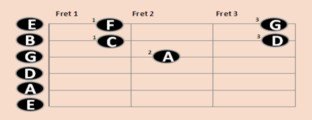Beginner classical guitar lesson 4 : Notes on the G string
All these free beginner classical guitar lessons have the same format. Have a look at how this page is layed out and become familiar with where things are. The heading tells you what the aim of the lesson is and the coloured box contains tips and guidelines. Below the coloured box are your guitar pieces that support the aim of the lesson and supporting resources which include accompaniment in mp3 format and free sheet music in pdf format.These lessons, designed for the beginner classical guitar player, build step by step with each lesson building on the previous lesson in the following ways: (i) knowledge of guitar technique; (ii) familiarity with music reading and (iii) strengthening - and in a safe way - your hands. Try and play through all the exercises provided at the bottom of the page. Remember that the house with the solid foundation is stronger in the long run.
I’m getting a lot of messages from people coming here because they want to learn to play guitar as part of worship. If this is you, you might want to join Aaron Anastasi’s programme. Aaron is a musician and a worship leader. He put together a step by step programme for aspiring Christian musicians. If you're interested, you can use the exercises and advice in learn-classical-guitar-today to develop your finger strength and dexterity and Aaron's lessons to work on strumming and worship music.
CLICK HERE TO LEARN WORSHIP GUITAR !!
Beginner Classical Guitar Lesson 4 - Aims
- Become familiar with and practice using the notes located on the G string (3rd string).
- Consolidate working with dotted notes.
- Your first introduction to music with two voices.
- Adding the p-i combination to the right hand fingering which till now has focussed only on the i-m-i-m-i-m fingering pattern.
Exercise 8
Exercise 1 to 7 are included in previous lessons . If you have not already completed these exercises, I suggest you go back and do them now. The links can be found below or on the navigation bar. Remember that the house with a solid foundation is far more stable.

I’m getting a lot of messages from people coming here because they want to learn to play guitar as part of worship. If this is you, you might want to join Aaron Anastasi’s programme. Aaron is a musician and a worship leader and put together a step by step programme for aspiring Christian musicians. If you are interested, you can use the exercises and advice in learn-classical-guitar-today to develop your finger strength and dexterity and Aaron's lessons to work on strumming and worship music. GO HERE TO LEARN WORSHIP GUITAR
Score with different voices
On the surface of it, this score looks a lot more difficult than the score that you've seen before. It isn't really once you understand how to count it and how to understand it. One of the big differences between solo classical guitar and other guitar genres such as folk or jazz is that classical guitarists play the melody, the rhythm and the accompaniment all at the same time whereas folk guitarists play the accompaniment and sing the melody and jazz guitarists - when playing with a band - will take up the role of either melody, rhythm or accompaniment (or combinations of these) at different moments. You've probably heard classical guitarists playing in the past and have wondered how it is that they sound as if their are more than one people playing. The secret lies in being able to seperate voices. The ability to do this well is one of the best kept secrets to classical guitar playing. Here is your first opportunity to get into voice seperation. Conceptualise the score - and in fact play it and sing it - as two different voices as indicated in the score below. Once you've made friends with each of the voices, you can put them together into once piece of music. This is a habit that you will need to use whenever you are confronted with a score with two voices. Always play through each voice seperately and become thoroughly familiar with each. Play through Exercise 12 and listen carefully for each of the voices. The mp3 below of the exercise and of the accompaniment will also be useful.
Click here for details on guitar supports including the Efel, the Dynarette and the Ergoplay.
Play along accompaniment for beginner classical guitar lesson 4
Two mp3s are provided for this lesson. The one contains both parts of the music and the other contains the accompaniment. Listen to both parts of the music played together so that you can get a feel of the song. Then practice by setting your metronome at a very slow pace. Slowly push up the speed until you can play it confidently at a metronome speed of 100. When you can play it confidently at this speed, you can play along to the accompaniment provided.
|
Listen to the song by playing this midi |
Play along with the accompaniment |
Tips and guidelines
| |||||||||
Great! Let's keep moving forward.
Okay, now you know the drill. The exercises provided below aim at developing the i-m-i-m movement of your right hand and your familiarity with the E string. Play through them by listening to the song and then playing along with the accompaniment. The sheet music can be downloaded by clicking on the PDF.
Some more exercises for practice
Listen to the song by playing this midi
Play along with the accompaniment
Listen to the song by playing this midi
Play along with the accompaniment
Well done!
Click here for the top three guitars that I recommend for beginners price range of $100 - $200 and intermediate level guitars which is a definite step up.
- You've finished your first 14 exercises, are now familiar with and practiced in using the notes of the 1st, 2nd and 3rd strings.
- You've practiced alternating between i-m-i-m-i-m with the right hand and have added using p-i combinations with the right hand
- You're now comfortable with the whole note, half note, quarter note and the dotted half note.
- A new aspect of your musicality was the introduction of music in multiple voices. You've now learnt how to approach these scores - remember to separate the voices and play them separately before attempting them together.
That's great progress and in a short period of time!

You'll need to go a little deeper into music theory as you proceed. The best online resource for this is Guitar Theory Revolution. It recognises that music theory is very hard for guitarists because music theory has till now been located in the piano paradigm. The Guitar Theory Revolution overthrows the piano paradigm that is holding you back and embraces the attributes of the guitar to unpack music theory. In fact, it goes further and allows you to see that the guitar is one of the best instruments for learning theory.
Moving forward
Let's move on to Lesson Five where you'll start using the eight note (or quaver) Just three more lessons and you'll be ready to play your first solo piece. Keep going through each of the lessons systematically. They've been designed to build up your technical capacity, your knowledge of the guitar and your understanding of the musicality that you will need.
Alternately, look through the lessons below and move to your preferred lesson
Lesson 1 - The E String: Start by familiarising yourself with the notes on the E string (1st String) by playing the pieces provided with the MP3 accompaniment. Practice alternating the i-m fingers of the right hand.
Lesson 2 - The B String: Learn and practice the notes on the B string (2nd string) by following the guidelines and playing the pieces with MP3 accompaniment provided. This lesson will help your fingers strength and the i-m right hand alternation will start becoming a little easier too.
Lesson 3 - The E and B String Together: Consolidate your learning of the E and B string by playing through the exercises which provide the opportunity to practice these notes to music arranged with accompaniment in MP3 format. Progress from whole notes, half notes and quarter notes which were used in previous lessons to dotted notes in this lesson.
Lesson 4 - The G String : Learn and practice the notes on the G string (3rd string) by following the guidelines and playing the pieces along with MP3 accompaniment. Enjoy your first introduction to playing music in two voices while allowing the i-m right hand finger combination to become second nature.
Lesson 5 - The D String Together: Become familiar with the D string (4th string) by playing the exercises with the accompaniment provided. Consolidate further working with dotted notes and working with music in two voices. Practice the p-i-m and i-m-p right hand combinations while using the quaver note for the first time.
Lesson 6 - The A String: Become familiar with the A string while you consolidate further your work with two voices and begin, for the first time, working in a new time signature. Practice the p-i-m and i-m-p right hand combinations while using the quaver note for the first time.
Lesson 7 - The E String: Your final lesson. On completion of this lesson you should be ready to prepare for your classical guitar examination Grade 1.






